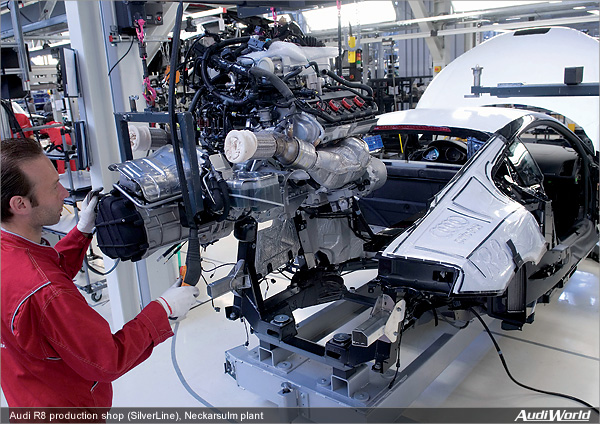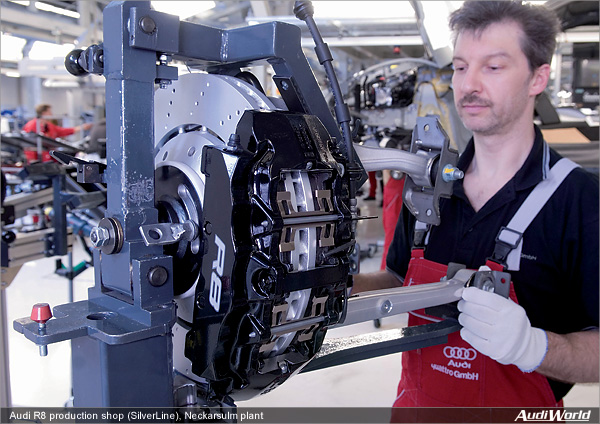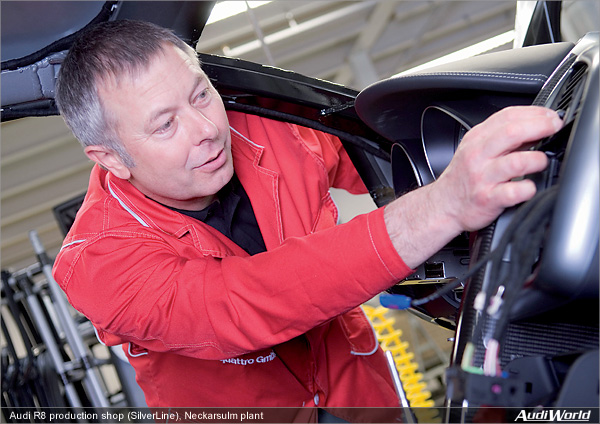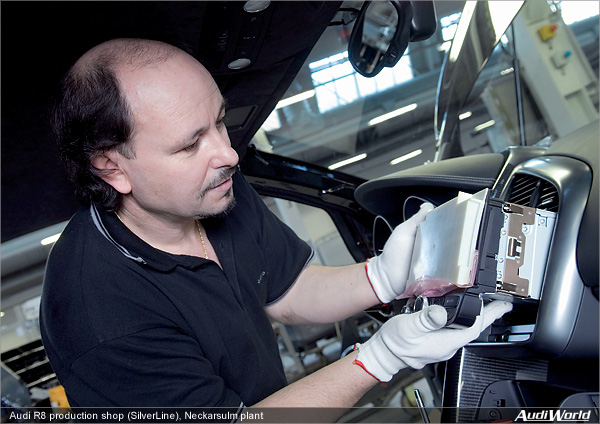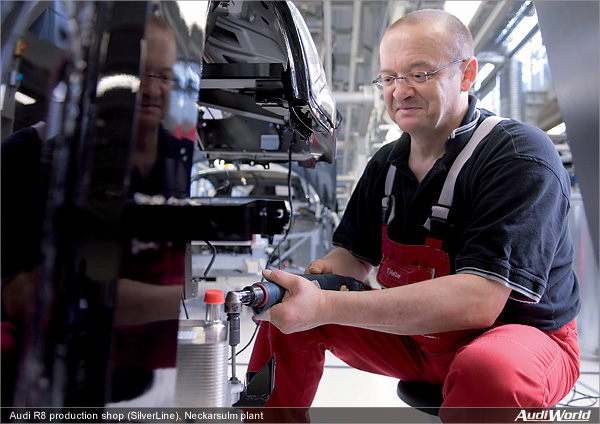Audi R8 Assembly in Neckarsulm: “SilverLiners” Set the Pace
Just look at me, says 53-year-old Jürgen Nölte, laughing and pointing at his greying hair. His job is production group leader, heading two groups, each with a dozen employees. About half of them are SilverLiners, Audi employees over 40 years old who round off the otherwise very young team in the R8 assembly. Of course the name SilverLine also alludes to our silvery hair, says Dr. Horst Mann, Head of Health Services at Neckarsulm and one of the drivers of the Human Resources project in R8 production. Dr. Werner Widuckel, Member of the Audi Board of Management for Human Resources, on whose initiative this pilot project was first conceived: In 5 years time, the average age of the Audi workforce will have increased by 5 to 45 years. We must therefore react to this right now in order to ensure that our staff remain employable and that we remain competitive. After all, the success of Audi is the success of our employees; they are our most prized asset.”
What is so special about R8 production? A work cycle in the R8 assembly last several times as long as a work cycle in volume production, for example on the A6. The long cycles, explains the medic, are an opportunity for highly varied sequences of movement. And that is exactly the opposite of production with short cycles, where very often exactly the same movement is made several hundred times a day. Jürgen Nölte has been with Audi since 1969. He comes from A6 production and knows from experience that there you have to make the same movement 250 to 300 times each shift once for every vehicle produced during that shift. With the R8, there are about ten cars per shift. That is good against one-sided stress but to do this, you have to be able to fit up to 50 different parts, not just two or three, Nölte adds. 50 different parts lying neatly sorted on a mobile cart, the so-called shopping trolley. A couple of metres away from the production line are the fresh supplies. Production managers call this area the supermarket because the staff take the goods they need from full shelves and fill up their shopping trolleys. The difference is that what goes in the trolley is not decided by personal taste, but rather by the production process. And this process is characterised by great calm. Hectic movements are as few and far between as the noise of machines or shouting. The body shells hang in height-adjustable frames that move on a few metres every three quarters of an hour. Whether the half-finished R8 is at knee level or at eye level depends on whether it is the windscreen wipers or the brakes that are being fitted. Work should be done in a posture that is as natural as possible, explains Dr. Ulrich Eritt, who is responsible for R8 production at quattro GmbH. He speaks with great respect for the work his staff perform.
Almost everything here is hand-crafted, and that starts in the body shop, where the various aluminium parts are joined by hand with about 100 metres of welding seams.” What looks like a complicated pattern from a needlecraft magazine is actually an assembly plan on which each individual welding seam is drawn with precisely defined start and end points. Maximum precision is required and a great deal of endurance. Intervening in the personnel policy with regard to the age structure of the team in the R8 assembly was only possible thanks to the interaction of all departments involved. The Chairman of the Works Council at Neckarsulm, Norbert Rank, has studied the SilverLine in detail and has supported the project: Lifelong learning is no empty phrase at Audi. Our colleagues put the experience and qualifications they have gained over many years to very good use in the SilverLine project. Thomas Helter (46) has worked on the Audi production line for 21 years and actively applied for R8 production: I said to myself, you’ve been doing the same thing for so long you need a new challenge. Today, he fits oil coolers, seat belts and cockpit modules on Audis first mid-engined sports car. For Helter it is thrilling to be part of the launch of such an extraordinary car. As he puts it: When you work on the R8, they look at you differently at home from when you work on the A6. For even if things are very quiet in the production hall, they work just as hard here as they do on every other Audi production line. Jürgen Nölte explains: A few people, young and old, want to go back to the regular production. For them, it is really stressful to be responsible for fitting 40 to 50 parts in a fixed order and to do it using up to twelve different tools. Short cycles such as are involved in volume production determine your working rhythm for you. Long cycles mean that you have to be able to set your own pace. Not only that, says Nölte, it is not age that is decisive to be able to work successfully in the R8 workshop, but rather a few years experience working on the production line with different tools and a good degree of level-headedness. Fernando Pereira (48) has both, even if he doesnt have a single grey hair as yet. Portuguese by birth, he first worked for Porsche and has now been at Audi for ten years. The Human Resources department asked him whether he would be interested in joining the SilverLine production and he agreed immediately. Today he fits, amongst other things, the centre console, side trims and radio in the R8 workshop. And he is clearly proud of what he does. Not everybody gets to work on the R8 a really beautiful car! And fitting many different parts is not a problem for me. You just have to keep your calm.
SilverLine a summary: What does SilverLine mean? Why? How does R8 production differ compared to volume production? How is the R8 assembly currently organised?
|

